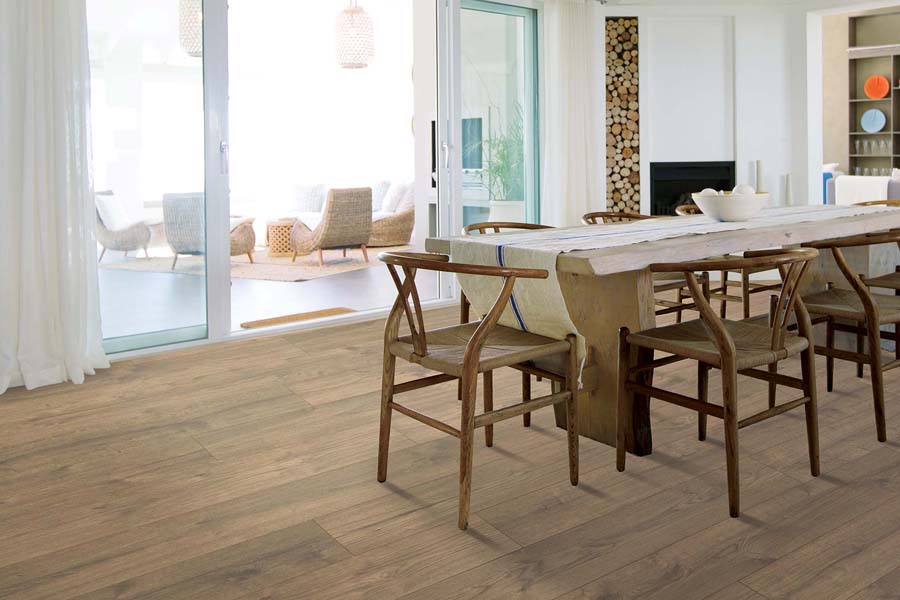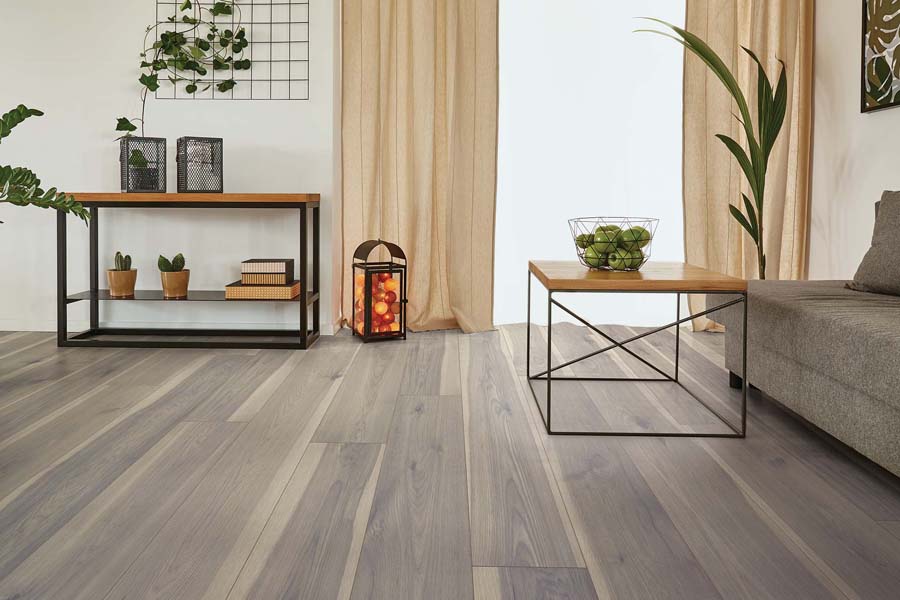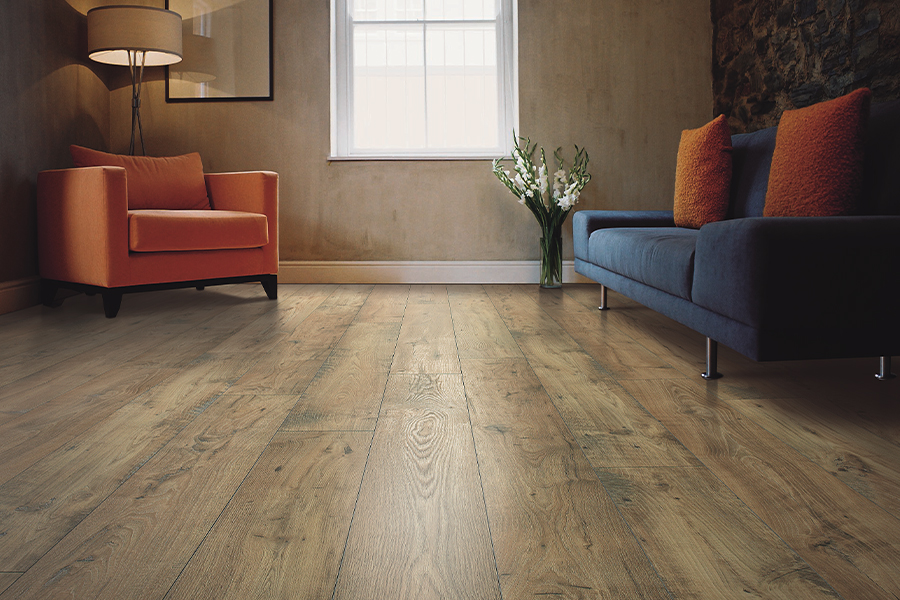Mohawk’s CARBCertification information! A Scandinavian Heritage
Northern Michigan’s Premier Laminate Flooring Store 3 convenient showrooms in Mancelona, Traverse City & Harbor Springs Laminate flooring represents the most significant flooring entry in the past 25 years. The product we know today as laminate flooring was originally developed as another possible use of high-pressure melamine laminate. This occurred in Sweden in the early 80s. A product was created with a base of several layers of paper, impregnated with special resins pressed together under high pressure into a highly wear resistant composite material. The decorative paper determined the design. The finished laminate was then glued onto a carrier and cut into sections with extremely exact dimensions. Decorative laminate was a product that was widely used on kitchen counter-tops, tables or wall paneling, but obviously not yet for floor covering. This clearly created an opportunity, but a flooring application brought new technical challenges. The initial concern to be solved was the wear factor. It is obvious that floors are walked on and therefore suffer a lot more normal abuse than furniture or counter tops. A laminate floor clearly had to be more durable. A reinforced laminate that was approximately 10 times stronger than counter tops was created and the first flooring began to be sold. As research grew, the relative strength of flooring laminate increased dramatically to at least 20 times that of countertops. Important parallel developments also were taking place during these early days. Packaging was one. Wood flooring at the time was normally sold in long strips of approximately eight feet and installed only by a skilled professional. Laminate flooring was different right from the beginning. It was packaged eight planks to a carton that was approximately half this length (about four feet). The easy-to-handle carton was fairly lightweight and could be transported by car or in an elevator with ease. Its carton contents equaled approximately 20 square feet (two square meters). Because of these revolutionary factors and ease of installation, a large do-it yourself market was created in Sweden that exists today. In fact, more than 90 percent of laminate flooring in Sweden still is self-installed!
Reasons for Acceptance
The system of gluing, using a tongue and groove method that, when done properly, creates a single unit that is impervious to normal household spills or tracked-in rain or snow. This single unit expands or contracts with changes in humidity. (This movement, by the way, cannot be seen)..
The strength of the bond in creating the single unit permits heavy objects, such as refrigerators or bookcases to be placed directly on the flooring.
Provided the glue is applied correctly, there is no problem with gaping. This process of installation is called a floating floor. The laminate floor can be laid or “floated” over the existing floor without being glued to the surface. This system also encapsulates the original floor. In most cases, (with the exception of textile), the older floor is not removed. This saves time and installation costs! Both the professional installer and the do-it-yourself customer quickly embraced the floating floor method because of the simplicity of installation and removal as compared to a glue down (to the subfloor) floor.
An easy removal process replaces the laminate floor at which point it can be destroyed with no danger to the atmosphere. Laminate floors contained insignificant quantities of elements that affected indoor air quality, plus it could be installed in a minimal amount of time.
The final ingredient for success (and an important one) is in the aesthetics of the floor. In the beginning virtually all the floors replicated were wood species. Why? Simply because these patterns were desired by the public. As laminate flooring grew in popularity, other looks were introduced, including marble and stone. One of the interesting aspects of laminate flooring is that the designs are limited only by the imagination of the producers.
This has resulted in a product that is now recognized by the design and decorating community for its ability to create an atmosphere of great beauty along with durability.
The strength of the bond in creating the single unit permits heavy objects, such as refrigerators or bookcases to be placed directly on the flooring.
Provided the glue is applied correctly, there is no problem with gaping. This process of installation is called a floating floor. The laminate floor can be laid or “floated” over the existing floor without being glued to the surface. This system also encapsulates the original floor. In most cases, (with the exception of textile), the older floor is not removed. This saves time and installation costs! Both the professional installer and the do-it-yourself customer quickly embraced the floating floor method because of the simplicity of installation and removal as compared to a glue down (to the subfloor) floor.
An easy removal process replaces the laminate floor at which point it can be destroyed with no danger to the atmosphere. Laminate floors contained insignificant quantities of elements that affected indoor air quality, plus it could be installed in a minimal amount of time.
The final ingredient for success (and an important one) is in the aesthetics of the floor. In the beginning virtually all the floors replicated were wood species. Why? Simply because these patterns were desired by the public. As laminate flooring grew in popularity, other looks were introduced, including marble and stone. One of the interesting aspects of laminate flooring is that the designs are limited only by the imagination of the producers.
This has resulted in a product that is now recognized by the design and decorating community for its ability to create an atmosphere of great beauty along with durability.
Request a consultation
The European Spread of Laminate Flooring
Three important attributes — durability, design and installation ease — now assured the popularity of laminate flooring in Europe. Following the early success in Scandinavia, other northern European countries, primarily Germany and the Benelux countries began to market laminate flooring. Distribution then spread quickly throughout the rest of Europe and continues today. Standards in Europe are being created by the CEN (Comité Européen de Normalisation or The European Committee for Standardization) group and will have the force of law. NALFA maintains a relationship with this important committee as well as EPLF (European Producers of Laminate Flooring). The interchange of ideas and technical data is viewed by NALFA as one of the most important areas of contribution.
Into North America
Laminate flooring crossed the Atlantic to North America in the early nineties and was brought quickly to the market. The results of this introduction surpassed even Europe.
The North American consumer discovered that s/he could have a product of beauty with incredible wear and unmatched stain resistance. American and Canadian kitchens quickly became the primary room for laminate floors. The consumer found out that virtually nothing could stain this beautiful floor — nor would sun or ultraviolet cause fade — and wear patterns were a thing of the past. And there were more benefits.
The resistance to indentation from heavy objects or shoes was far greater than popular existing wood or vinyl floors. The floor was incredibly easy to clean — vacuuming or damp mopping was needed. There was no need for waxing or stripping of the old wax buildup.
The retailer enjoyed unexpected ease of stocking and servicing. Dye lots, found in ceramic or textile, are non-existent in laminate flooring. This retailer benefit also assured the consumer of exact match in tone and color, even if additional matching flooring was purchased and installed a year later!
Besides importers, U.S. and Canadian manufacturing operations began to produce the product. Laminate flooring was on its way to another success. North America took to this new category of beautiful flooring with its remarkable qualities in unparalleled numbers.
Today, laminate flooring continues its remarkable growth. Virtually every room of the house, including bathrooms is benefiting from a laminate floor application. The commercial marketplace is now exploring the aspects of laminate flooring for its demanding situations.
The North American consumer discovered that s/he could have a product of beauty with incredible wear and unmatched stain resistance. American and Canadian kitchens quickly became the primary room for laminate floors. The consumer found out that virtually nothing could stain this beautiful floor — nor would sun or ultraviolet cause fade — and wear patterns were a thing of the past. And there were more benefits.
The resistance to indentation from heavy objects or shoes was far greater than popular existing wood or vinyl floors. The floor was incredibly easy to clean — vacuuming or damp mopping was needed. There was no need for waxing or stripping of the old wax buildup.
The retailer enjoyed unexpected ease of stocking and servicing. Dye lots, found in ceramic or textile, are non-existent in laminate flooring. This retailer benefit also assured the consumer of exact match in tone and color, even if additional matching flooring was purchased and installed a year later!
Besides importers, U.S. and Canadian manufacturing operations began to produce the product. Laminate flooring was on its way to another success. North America took to this new category of beautiful flooring with its remarkable qualities in unparalleled numbers.
Today, laminate flooring continues its remarkable growth. Virtually every room of the house, including bathrooms is benefiting from a laminate floor application. The commercial marketplace is now exploring the aspects of laminate flooring for its demanding situations.















